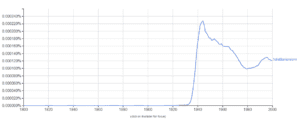It seems that “totalitarianism” is everywhere these days. I suppose that is the point of totalitarianism. Nonetheless, the buzzword has seen a remarkable resurgence in popular usage and misusage in the context of domestic and international politics. The number of articles comparing Trump to a totalitarian ruler are not easily countable (though here and here are some examples). Some, have attributed current US foreign policy issues related to North Korea’s development of nuclear weapons as relating to a battle against a totalitarian regime. And others—notably from the conservative side of the political spectrum—have characterized certain political movements such as calls to remove Confederate statues and the so-called “Antifa” movement, forms of totalitarian ideology.
Totalitarianism is a part of political discourse in 2017. This raises several questions, one of which is the obvious: What does this term mean? And, related: How can this term be mobilized to condemn a wide variety of different political acts—from protests for social justice, to the Trump administration, to North Korea?
As a political scientist who researches discourse, and who writes about totalitarianism as a concept during the Cold War, I want to work through some of the issues associated with this term, explain what its political origins are, and suggest why it might not be the most analytically useful term for policy analysis.
Here are five facts about totalitarianism we all need to know:
1. The term is not that old. Totalitarianism as the concept of the state having total control over the lives of its subjects is actually not an ancient idea. Though there are debates about its precise origin, the early history of the concept is one that dates to religious conflict in the US. In the early 1920s, American Catholics—who were embroiled in a set of battles against the KKK and others—were branded ideological totalitarians, and were accused of supporting Mussolini and Franco during their rise in power. Catholics, ironically, would take this accusation and turn it against the likes of so-called totalitarian theorists in the 1930s, like Carl Schmitt.
As the Google N-Gram graph below shows, this term has little usage before the 1920s/1930s, and explodes in frequency during and immediately after WWII.
2. Definitions and histories have never been agreed on. Some of you are probably reading this and thinking, “I expected this guy to tell us a history of totalitarianism and explain how we got to the present;” however, major studies of totalitarianism—the classic texts genealogizing this concept—have vastly different interpretations.
Two prominent examples are worth comparing.
The first is Hannah Arendt’s classic Origins of Totalitarianism, which found the origin of modern totalitarianism in the modern development of anti-Semitism and imperialism in Europe. With anti-Semitism came the ideological justification to erase entire peoples, and with imperialism came the physical and administrative ability to do so.
Compare this history with another influential one given by historian Jacob Talmon. In his Origins of Totalitarian Democracy, Talmon credits a different source: The rise of a political messianism immediately before and after the French Revolution which tied freedom to an intense collectivism (viz., it was all Rousseau’s fault!). As he notes, in his work Romanticism and Revolt, after the revolution “‘Liberté’ had become an opportunity and instrument for self-willed arbitrariness and the rule of brute force.” (p. 124).
These narratives are irreconcilable. One sees this movement starting in the 19th century with bourgeois and conservative reactionism, while the other sees its beginnings 100 years earlier in the ideas of theorist we usually associate with freedom and liberalism.
3. It is a political and historical project. There is a wide variety of explanations for these divergent narratives. The simplest, however, is that Cold War writers who used this term, wrote its histories, and expanded its boundaries, did so with specific political purposes. Arendt’s and Talmon’s were different. Arendt primarily wanted to understand how the Third Reich was able to come to power. Talmon, as a paradigmatic Cold War liberal, was more interested in showing how communist ideology—of the Soviet type—came into being.
The political connotations of this term have led some to characterize it as a significant artefact of Cold War ideology. As Efraim Podoksik argues in an illuminating article, “Anti-totalitarianism is a specific twentieth century ideology.” (p. 208).
It is more useful to consider the term “totalitarianism” not as an analytically precise term; rather, it is a powerful discourse used to serve political means. One of the most startling illustrations of this is the fact that this discourse was almost never used by Cold War intellectuals to describe aspects of American history, even when such a narrative could be written.
4. It is not a term widely used in the comparative study of regimes. It is also important to note, rather briefly, that totalitarianism, as a way of describing regimes, is not popularly used in the comparative politics literature. I asked a friend of mine, who is a scholar of comparative politics, whether this term is ever used. His response: No. We say “authoritarian.”
This is confirmed in the academic literature. A recent survey of the typological literature on authoritarianism shows that focus has tended to be on party ideology or institutional forms (e.g., one party state, military dictatorship, etc.).
Why does this matter? There is a reason comparativists (the people who study regimes and how they work) do not tend to use these terms. Their analytic usefulness in contrast to other schema is limited.
5. Poetics and literary traditions of totalitarianism. Finally, it is worth noting that our popular understandings of contemporary totalitarianism are not based on contemporary politics. Of course, we relate totalitarianism as a descriptive category to describe the Soviet Union in the mid-twentieth century, and the horrors of the Holocaust, but much of our current references are not to places with totalitarian rule, but with archetypes of totalitarianism in literature.
Let me explain. In one undergraduate textbook I found that actually does dedicate some generous space to totalitarianism, the only contemporary example it gives is North Korea.
Instead, what many of us imagine is based on popular media, and especially speculative fiction, in what I call a “poetics of totalitarianism.” Atwood’s, The Handmaid’s Tale, Orwell’s 1984 (written in the midst of the Cold War), Lowry’s The Giver, and others have instilled this fear of totalitarianism—what two analysts call “tyrannophobia”—into the popular consciousness.
The problem, and why poetics (the aesthetic function of literature) matters, is that fiction is not always a reliable mirror to reality. In fact, totalitarianism as a theme is often effective just in the sense of these aesthetics—it presents a seemingly insurmountable problem for protagonists to surmount. The images evoked by these pieces of literature are captivating, and contribute to this tyrannophobia of the contemporary age. We worry about the possibilities of a Hunger Games situation. Not because that scenario exists in reality, but because it’s part of our cultural consciousness.
This long-winded post, it should be noted, is not meant to downplay in any way the egregious, catastrophic, and world-shaking effects of political movements like fascism, Stalinism, or the like. What I hoped to illustrate is that it is easy to throw around terms like totalitarianism to account for things we are horrified by, or even for things that are otherwise great evils. After all, this is in some ways what Cold War intellectuals like Arendt and Talmon do in their own narratives of totalitarianism. If we want to fight these evils, what is needed are the analytical tools to do so. Unfortunately, totalitarianism as a concept is not that tool. We should be cautious of invoking its name in public debate.
Dillon Tatum is an assistant professor in the Department of Political Science and Geography at Francis Marion University. His research and teaching focuses are at the intersection of international relations and political theory—with a specific interest in the international liberalism, military intervention, and global ethics. He is currently working on a book manuscript titled Liberalism and Transformation: The Politics of Violence in World Politics, which is a critical history of international liberalism’s relationship with military intervention from the nineteenth century to present. He can be found on twitter at: @dstonetatum



I suspect that part of its popularity comes from the wishy-washy sound of “authoritarian”. Troubled times need words with strong consonants in them.
As a professor of literature, I can appreciate your explanation of the “poetics of totalitarianism.” Fiction is not always a reliable mirror to reality.